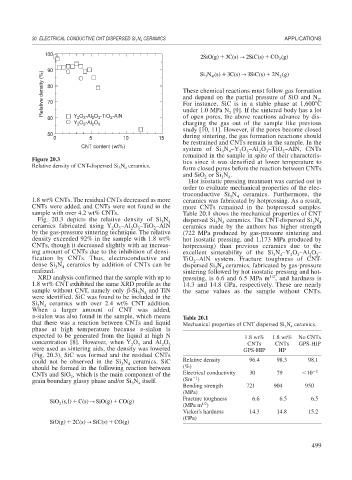Page 527 - Book Hosokawa Nanoparticle Technology Handbook
P. 527
20 ELECTRICAL CONDUCTIVE CNT DISPERSED Si N CERAMICS APPLICATIONS
3 4
100
2SiO(g) 3C s() 2SiC(s) CO g)
(
2
90 Si N s() 3 C s() 3 SiC(s) 2 N g)
Relative density (%) 80 These chemical reactions must follow gas formation
(
2
3
4
and depend on the partial pressure of SiO and N .
2
70
For instance, SiC is in a stable phase at 1,600 C
2
of open pores, the above reactions advance by dis-
60 Y 2 O 3 -Al 2 O 3 -TiO 2 -AlN under 1.0 MPa N [9]. If the sintered body has a lot
Y O -Al O 3 charging the gas out of the sample like previous
2
3
2
study [10, 11]. However, if the pores become closed
50
0 5 10 15 during sintering, the gas formation reactions should
be restrained and CNTs remain in the sample. In the
CNT content (wt%)
system of Si N –Y O –Al O –TiO –AlN, CNTs
3
2
2
3
2
4
3
remained in the sample in spite of their characteris-
Figure 20.3 tics since it was densified at lower temperature to
Relative density of CNT-dispersed Si N ceramics. form closed pores before the reaction between CNTs
4
3
and SiO or Si N .
4
2
3
Hot isostatic pressing treatment was carried out in
order to evaluate mechanical properties of the elec-
troconductive Si N 4 ceramics. Furthermore, the
3
1.8 wt% CNTs. The residual CNTs decreased as more ceramics was fabricated by hotpressing. As a result,
CNTs were added, and CNTs were not found in the more CNTs remained in the hotpressed samples.
sample with over 4.2 wt% CNTs. Table 20.1 shows the mechanical properties of CNT
Fig. 20.3 depicts the relative density of Si N 4 dispersed Si N ceramics. The CNT-dispersed Si N 4
3
3
3
4
ceramics fabricated using Y O –Al O –TiO –AlN ceramics made by the authors has higher strength
2
2
3
3
2
by the gas-pressure sintering technique. The relative (722 MPa produced by gas-pressure sintering and
density exceeded 92% in the sample with 1.8 wt% hot isostatic pressing, and 1,173 MPa produced by
CNTs, though it decreased slightly with an increas- hotpressing) than previous ceramics due to the
ing amount of CNTs due to the inhibition of densi- excellent sinterability of the Si N –Y O –Al O –
2
4
3
3
3
2
fication by CNTs. Thus, electroconductive and TiO –AlN system. Fracture toughness of CNT-
2
dense Si N ceramics by addition of CNTs can be dispersed Si N ceramics, fabricated by gas-pressure
4
3
4
3
realized. sintering followed by hot isostatic pressing and hot-
XRD analysis confirmed that the sample with up to pressing, is 6.6 and 6.5 MPa m , and hardness is
1/2
1.8 wt% CNT exhibited the same XRD profile as the 14.3 and 14.8 GPa, respectively. These are nearly
sample without CNT, namely only -Si N and TiN the same values as the sample without CNTs.
3
4
were identified. SiC was found to be included in the
Si N ceramics with over 2.4 wt% CNT addition.
3
4
When a larger amount of CNT was added,
-sialon was also found in the sample, which means Table 20.1
that there was a reaction between CNTs and liquid Mechanical properties of CNT dispersed Si N ceramics.
phase at high temperature because -sialon is 3 4
expected to be generated from the liquid at high N 1.8 wt% 1.8 wt% No CNTs
concentration [8]. However, when Y O and Al O 3 CNTs CNTs GPS-HIP
2
3
2
were used as sintering aids, the density was lowered GPS-HIP HP
(Fig. 20.3), SiC was formed and the residual CNTs
could not be observed in the Si N ceramics. SiC Relative density 96.4 98.3 98.1
4
3
should be formed in the following reaction between (%) 5
CNTs and SiO , which is the main component of the Electrical conductivity 30 79 10
2
1
grain boundary glassy phase and/or Si N itself. (Sm )
3 4
Bending strength 721 904 950
(MPa)
(,
SiO s l) C s) SiO g) CO g) Fracture toughness 6.6 6.5 6.5
(
(
(
1/2
2
(MPa m )
Vicker’s hardness 14.3 14.8 15.2
SiO(g) 2C s() SiC(s) CO(g) (GPa)
499

